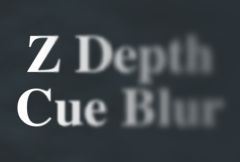S_ZDepthCueBlur
Blurs areas of the source clip by different amounts using depth values from a ZBuffer input. Separates the input into a number of layers between Z Near and Z Far and blurs them by different amounts depending on Blur Near and Blur Far. Linear fog can also be mixed into the result.In the Sapphire Blur+Sharpen effects submenu.
Inputs:
-
Source: The current layer. The clip to be processed.
- ZBuffer: Defaults to None. The input clip containing depth values for each Source pixel. These values should be in the range of black to white. Normally black corresponds to the nearest objects and white to the farthest.

|